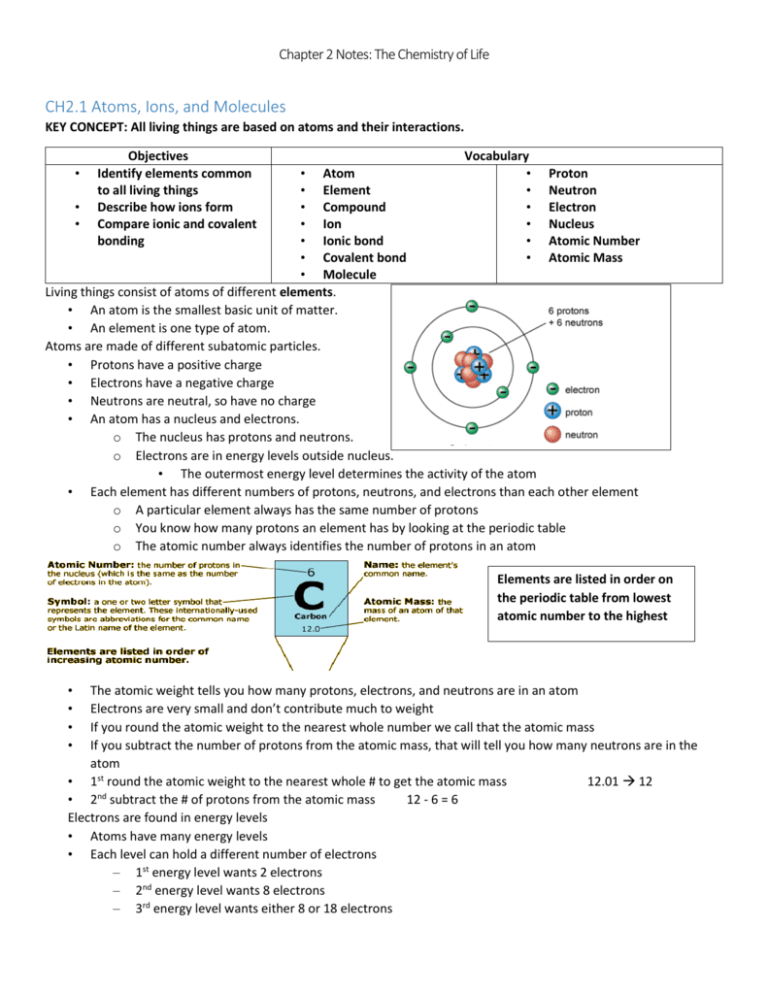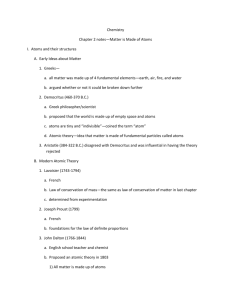CH2.1 Notes Page
advertisement

Chapter 2 Notes: The Chemistry of Life CH2.1 Atoms, Ions, and Molecules KEY CONCEPT: All living things are based on atoms and their interactions. • Objectives Identify elements common to all living things Describe how ions form Compare ionic and covalent bonding Vocabulary • • • • • • • Atom Proton • Element Neutron • • Compound Electron • • Ion Nucleus • Ionic bond Atomic Number • Covalent bond Atomic Mass • Molecule Living things consist of atoms of different elements. • An atom is the smallest basic unit of matter. • An element is one type of atom. Atoms are made of different subatomic particles. • Protons have a positive charge • Electrons have a negative charge • Neutrons are neutral, so have no charge • An atom has a nucleus and electrons. o The nucleus has protons and neutrons. o Electrons are in energy levels outside nucleus. • The outermost energy level determines the activity of the atom • Each element has different numbers of protons, neutrons, and electrons than each other element o A particular element always has the same number of protons o You know how many protons an element has by looking at the periodic table o The atomic number always identifies the number of protons in an atom Elements are listed in order on the periodic table from lowest atomic number to the highest • • • • The atomic weight tells you how many protons, electrons, and neutrons are in an atom Electrons are very small and don’t contribute much to weight If you round the atomic weight to the nearest whole number we call that the atomic mass If you subtract the number of protons from the atomic mass, that will tell you how many neutrons are in the atom • 1st round the atomic weight to the nearest whole # to get the atomic mass 12.01 12 nd • 2 subtract the # of protons from the atomic mass 12 - 6 = 6 Electrons are found in energy levels • Atoms have many energy levels • Each level can hold a different number of electrons – 1st energy level wants 2 electrons – 2nd energy level wants 8 electrons – 3rd energy level wants either 8 or 18 electrons Chapter 2 Notes: The Chemistry of Life Atoms want to be stable • Energy levels want to be full of electrons • Lower energy levels always fill up before higher energy levels • The 3rd energy level won’t have any electrons unless 1 and 2 are full • If the energy level isn’t full, the atom is not stable and will react with other atoms and form bonds and become stable Atoms can gain, lose, or share electrons to become stable • The outermost energy level of an atom is called its valence shell • Electrons in the outermost energy level are called valence electrons • It’s the valence electrons that determine – what types of bonds will form – How many bonds will form • A compound is made of atoms of different elements bonded together. Different Compounds are held together by different types of bonds • Covalent Bonds: – Atoms share pairs of electrons in covalent bonds – Compounds held together by covalent bonds are called molecules • Ionic Bonds – Sometimes its easier for an atom to gain or lose an electron than to share – An ion is an atom that has gained or lost one or more electrons. – Atoms that gain electrons • Are called anions • what kind of charge will an anion have? • Atoms that lose electrons • Are called cations • what kind of charge will an cation have? – Ionic bonds form between oppositely charged ions. • Hydrogen Bonds • The type of bond that will form depends on the number of valence electrons 1. What distinguishes one element from another? 2. Describe the formation of an ionic compound? 3. What is the difference between an ionic and a covalent bond? 4. How does a molecule differ from an atom? 5. Explain why a Hydrogen atom can become either an ion or a part of a molecule? 6. A sodium atom has one outer electron, and a carbon atom has 4 outer electrons. How might this difference be related to types of compounds formed by atoms of these 2 elements?






